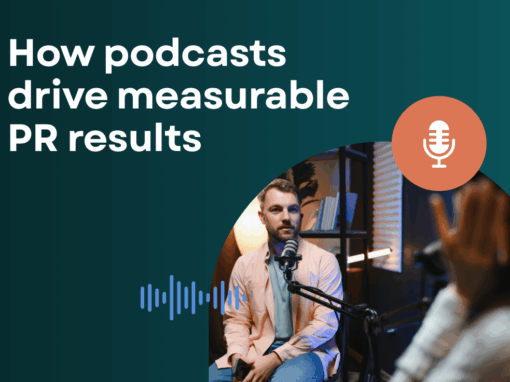The PR industry has shifted from vanity metrics to value-driven measurement in recent years (and rightly so). Comparison analysis, which used to be a nice-to-have, is fast-becoming a staple in PR reporting as a result.
Comparing datasets, whether that be across time, campaigns, tiers or regions, for example, unlocks deeper insights for powerful PR data storytelling that demonstrates the real ROI of PR. And let’s face it, us PR pros need all the help we can get proving PR value to the C-suite in the current economic climate.
Think about it. What would you rather tell the C-suite (or clients if you work in a PR agency)? That you secured 40 pieces of coverage in Q3 or that you secured 40 pieces of coverage in Q3, an increase of 35% on the previous quarter with a 50% rise in key message penetration? I know which statement I’d prefer to use!
But it’s not just about showing the results of PR to stakeholders and C-suite. Oh no, comparison data also gives PR teams the opportunity to optimise or change direction.
Proving/validating PR’s impact to the C-suite was cited as a challenge by 27% of respondents in Cision’s 2025 Comms Report.
Time-based comparisons
One of the most obvious comparisons in PR (and beyond) is time. Month-on-month, quarter-on-quarter and year-on-year analysis helps PR agencies and in-house comms teams determine whether their earned media strategies are actually building sustained brand awareness.
You can also use analytics to improve your PR strategy. If the data suggests improvements aren’t being made over time, teams can tweak their PR strategies long before the next PR update or board review.
Time-based comparisons are also crucial when defending PR spend. After all, if stakeholders see that sentiment or engagement is increasing, it makes it much easier for PR leaders to position PR as an investment rather than a cost.
Key message penetration
Comparing key message penetration over time, or even on a campaign basis, is a great way to show that narrative is being controlled and communicated effectively. And, of course, it shows PR is aligned with business priorities. What’s not to like?
Market and audience comparisons
Tailouring messaging to account for regional nuances is time-consuming, but it’s necessary. By comparing results across geographies, PR teams can pinpoint the locations where messaging is resonating, or perhaps not quite hitting the mark.
The data might show you have stronger relationships with the press in one region, for example. Therefore, you might decide to allocate more time to media outreach and relationship building in certain regions for the next campaign as a result.
Channel comparisons
We all know that press coverage in tier one publications help to drive authority and visibility, but other channels, like social, are often better for driving conversions. Channel comparisons can help you better align resources and effort. After all, once you’ve reviewed the data, you might decide to double down on high-impact channels and even cut channels that aren’t providing results.
Benchmarking against competitors
We’ve all been asked why a main competitor managed to secure coverage in The Times, The Guardian, the BBC (and so on). Back in the day, it was a tough question to answer as sometimes the reason why might not have been obvious. But now with competitive benchmarking, you can answer the question without squirming.
Evaluating your brand’s share of voice, sentiment, and key message penetration against competitors, gives you context on relative performance.
A competitor may well have more coverage overall (it does happen), but if your brand achieves higher recall scores, stronger message alignment, or greater engagement on key topics, you really can prove your comms strategy is more effective. Phew!
Opportunity knocks
Competitive comparisons also reveal opportunities for improvement. For instance, if your competitors are all heavily pushing one message like sustainability or low cost, you can advise the board (or your clients if you work in a PR agency) to reposition messaging to something that differentiates to gain a strategic advantage.
“Comparing datasets doesn’t just make your reporting better, it makes your storytelling stronger, elevating your reputation in the process.”
–Richard Benson, CEO, Releasd
The value of comparison in the boardroom
Effective PR reporting isn’t just about gathering data. It’s about communicating what the data means effectively and then using the data to initiative change and drive outcomes.
Charts and graphs that show change over time, or summary statements that quantify improvement ensure that PR reports are not just digestible but compelling.
Think about it, if you can clearly show that competitor mentions have dropped while your own narrative has gained traction, the value of PR really does become undeniable to stakeholders.
How to track leads from your PR campaign in Salesforce
Top tips for those wanting to use comparative data into PR reports
- When you start building your PR reports, think about how you’re going to highlight change and variance rather than just totals.
- Be sure to maintain consistent data definitions across all your PR reports to ensure comparisons are up to date.
- Agree on the benchmarks you want to use for what good performance looks like and make sure you review and update them as strategies evolve. For example, showing the amount of attention that editorial coverage has received is helpful to PR professionals looking to prove that they’ve driven brand awareness at scale.
- Combine PR metrics with other, non-PR sources of information to enhance your narrative further. Consider using Google Analytics to track conversions from PR-led activity or use data from your CRM to track leads generated from PR campaigns.
Streamline your PR reporting and show real impact with Releasd.
Releasd PR reports can be split into different sections based on coverage tiers, regions, campaigns and more. It’s now easy to get data for each specific section – and then wrap it up for the whole report. In the video below, Releasd CEO Richard Benson, explains how it’s done.



